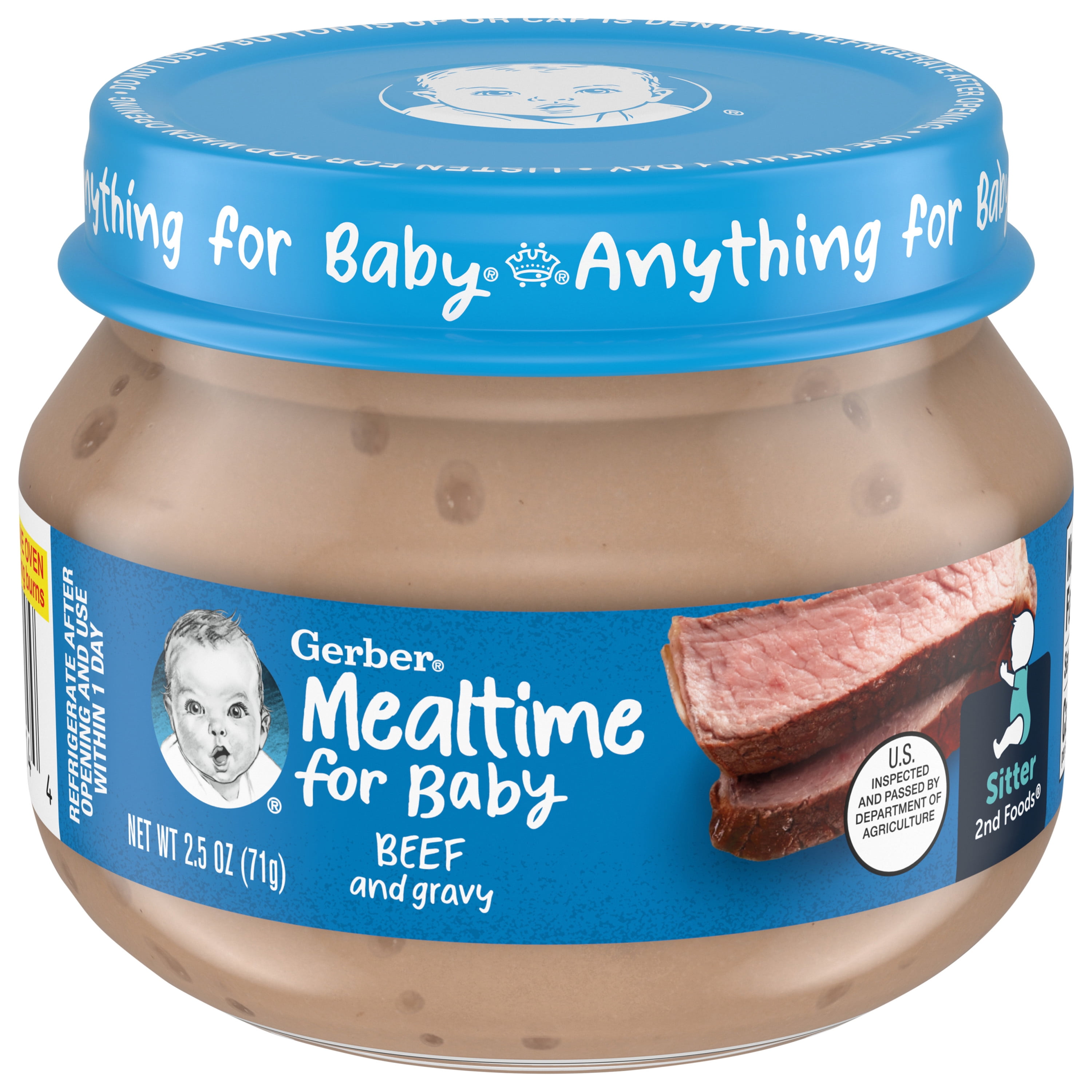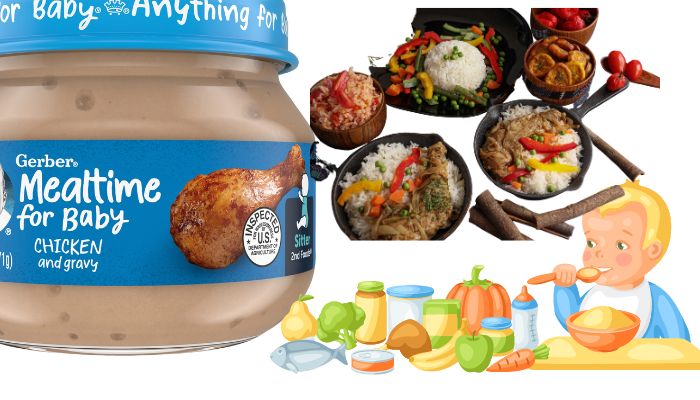Are you curious about meat baby food? Well, you’ve come to the right place! In this article, we’ll explore the world of meat-based purees and how they can be a nutritious and tasty option for your little one’s diet. So, let’s dive in!
Introducing meat to your baby’s diet can be an exciting milestone. Not only does it provide essential nutrients like iron and protein, but it also introduces new flavors and textures to expand their palate. In this guide, we’ll discuss the benefits of meat baby food and explore some delicious and easy-to-make recipes.
If you’re wondering how to make meat baby food at home, don’t worry; we’ve got you covered! We’ll share some simple tips and tricks to prepare tasty meat purees that your little one will love. So, get ready to embark on an adventure of flavor and nutrition with meat baby food! Let’s get started!
Why buy store-bought when you can create your own homemade baby food? Follow these simple steps to prepare wholesome meat purees for your little one:
Step-by-Step Guide:
- Select a suitable cut of meat.
- Cook the meat thoroughly.
- Let it cool, then chop into small pieces.
- Purée the meat using a food processor or blender.
- Divide into small portions and freeze for future use.
By making your own meat baby food, you have control over the ingredients, ensuring your baby gets the best nutrition available.
Exploring the World of Meat Baby Food
Welcome to our in-depth guide on meat baby food. In this article, we will delve into the world of introducing meat to your baby’s diet. We’ll discuss the benefits, tips for preparation, and answer common questions about this important stage of your little one’s nutritional journey.
The Benefits of Introducing Meat to your Baby’s Diet
Introducing meat to your baby’s diet brings a host of benefits. Firstly, meat is rich in essential nutrients like iron, zinc, and protein, which are crucial for your baby’s growth and development. Iron, for example, is vital for brain development and the creation of red blood cells. By introducing meat early on, you can help prevent iron deficiency anemia in your baby.
Meat also provides important fatty acids, like omega-3, which promote brain health. Additionally, the protein found in meat helps build and repair tissues, ensuring proper muscle development. Including meat in your baby’s diet can also enhance the taste and texture variety, making mealtime more exciting and enjoyable for your little one.
Lastly, introducing meat to your baby’s diet early on can help develop healthy eating habits and expand their palate. Starting your baby on a varied diet that includes meat sets the foundation for a diverse and balanced diet as they grow older.
Choosing the Right Meat for Your Baby
When it comes to selecting meat for your baby, it’s important to opt for high-quality sources. Organic and grass-fed meats are preferred, as they are often free from hormones and antibiotics. It’s also crucial to choose lean cuts of meat to avoid excessive fat intake.
Common meats to introduce to your baby include chicken, turkey, beef, and lamb. These meats are easy to digest and have a milder flavor, making them suitable for young palates. It’s best to start with pureed or finely minced meats, gradually increasing the texture and size as your baby gets older and more comfortable with solid foods.
It’s essential to cook the meat thoroughly to ensure it is safe for your baby to consume. Avoid adding salt, seasoning, or additives to the meat. The goal is to introduce the natural flavors and nutrients of the meat itself. As your baby grows and develops, you can begin to incorporate a variety of spices and herbs to further enhance the taste and expand their culinary experiences.
Preparation Tips for Meat Baby Food
Preparing meat baby food can be a simple and straightforward process. Here are some tips to help you get started:
- Begin by selecting fresh, high-quality meat. Ensure it is within its expiration date and free from any discoloration or spoilage.
- Trim any excess fat and remove bones from the meat before cooking.
- Cook the meat thoroughly by boiling, baking, or steaming until it is tender and easy to mash or puree.
- Once cooked, allow the meat to cool before handling. This ensures the safety of your baby and makes it easier to handle.
- Use a blender or food processor to puree the cooked meat, adding a small amount of water or breast milk to achieve a smooth consistency.
- For older babies who are ready for more texture, you can finely mince the cooked meat or offer small, bite-sized portions.
- Store any leftover meat baby food in airtight containers or ice cube trays in the freezer for future use. Be sure to label the containers with the date to maintain freshness.
Remember to always consult with your pediatrician before introducing meat or any new foods to your baby’s diet. They can provide personalized guidance and ensure a smooth transition into solid foods.
Common Concerns and Questions about Meat Baby Food
As with any new endeavor, introducing meat to your baby’s diet may raise some concerns or questions. Let’s address a few common ones:
When can I start introducing meat to my baby?
Most babies can begin trying pureed meat between 6 to 8 months of age. However, it’s important to consult with your pediatrician as every child’s development is unique.
How much meat should I offer my baby?
Start with small portions, around 1-2 tablespoons, and gradually increase the amount as your baby develops and shows interest in solid foods.
What if my baby has a reaction to meat?
If you notice any adverse reactions such as rash, vomiting, or diarrhea after introducing meat, stop feeding it to your baby and consult your pediatrician. They can determine if your baby has an allergy or sensitivity to the meat and provide appropriate guidance.
Can I introduce different types of meat at once?
It’s recommended to introduce one type of meat at a time, waiting a few days before introducing another. This allows you to monitor your baby for any potential allergies or sensitivities to specific meats.
What are some alternative protein sources for babies?
If you prefer to explore alternative protein sources, lentils, beans, tofu, and cottage cheese can be introduced to your baby’s diet. These options offer plant-based protein and can provide variety and nutrition.
Recipes and Meal Ideas for Meat Baby Food
Now that we’ve covered the basics of introducing meat to your baby’s diet, let’s explore some delicious and nutritious recipes to get you started.
1. Chicken and Vegetable Puree
This simple recipe combines chicken with a variety of vegetables for a balanced and flavorsome puree.
Ingredients:
- 1 boneless, skinless chicken breast
- 1 small carrot, peeled and chopped
- 1 small zucchini, peeled and chopped
- 1/2 cup of low-sodium chicken broth
Instructions:
- In a saucepan, bring the chicken broth to a boil.
- Add the chicken breast and vegetables to the saucepan.
- Cover and simmer for 15-20 minutes or until the chicken is cooked through and the vegetables are tender.
- Remove the chicken breast and vegetables from the saucepan and allow them to cool slightly.
- Puree the chicken and vegetables in a blender or food processor until smooth.
- Serve immediately or store in airtight containers for future use.
This puree can be served alone or mixed with cooked rice or mashed sweet potatoes for added texture and flavor.
2. Beef and Sweet Potato Mash
This hearty mash combines beef with the natural sweetness of sweet potatoes for a nutritious meal.
Ingredients:
- 1/4 cup lean ground beef
- 1 small sweet potato, peeled and diced
- 1/4 cup low-sodium beef broth
Instructions:
- In a skillet, cook the ground beef until browned. Drain any excess fat and set aside.
- In a saucepan, bring the beef broth to a boil.
- Add the diced sweet potato to the saucepan and simmer until tender.
- Once the sweet potato is cooked, drain any excess liquid and mash it with a fork or potato masher.
- Add the cooked ground beef to the mashed sweet potato and mix well.
- Allow the mixture to cool before serving.
This mash can be served as a standalone meal or mixed with other pureed vegetables for added variety.
Conclusion:
Introducing meat to your baby’s diet is an exciting step in their nutritional journey. It offers a wide range of benefits and helps develop healthy eating habits. By following the tips and recipes provided in this article, you can ensure a smooth and enjoyable transition to meat baby food. Remember to consult with your pediatrician for personalized guidance and enjoy exploring the world of meat with your little one!
Key Takeaways: Meat Baby Food
- Meat baby food provides important nutrients for infants’ growth and development.
- Introducing meat to babies can help in the formation of strong muscles and bones.
- It is recommended to start introducing meat to babies around 6-8 months of age.
- Make sure the meat is well cooked and mashed into a texture suitable for your baby.
- Offer a variety of meat options to expose your baby to different flavors and textures.
Frequently Asked Questions
Welcome to our FAQ section on meat baby food! Here, we’ve gathered answers to common queries parents have about introducing meat into their baby’s diet. Read on to find out more.
1. When can I start introducing meat to my baby’s diet?
It is generally recommended to wait until your baby is around 6 to 8 months old before introducing meat. Start with pureed or finely minced meat and offer it in small amounts. Make sure it is well-cooked and tender to ensure easy digestion for your little one.
Remember, every baby is different, so talk to your pediatrician or healthcare professional for personalized guidance. They can help determine if your baby is ready for meat and advise on how to safely introduce it into their diet.
2. Why is meat an important food for babies?
Meat is an excellent source of iron, protein, and essential vitamins and minerals that support healthy growth and development in babies. Iron is especially important as it helps carry oxygen throughout the body and supports brain development.
While iron-fortified baby cereals provide some iron, incorporating meat into your baby’s diet can enhance their iron intake. It is important to offer a variety of protein sources, including meat, to ensure your baby gets all the essential nutrients they need.
3. Can I offer any type of meat to my baby?
When introducing meat to your baby, opt for lean and tender options such as chicken, turkey, beef, or pork. Always remove skin, bones, and excess fat before cooking and serving. Avoid processed meats like hot dogs or sausages, as they may contain additives that are not suitable for babies.
Additionally, it’s a good idea to start with poultry before introducing red meat to your baby. This can help minimize the risk of allergies and sensitivities. Remember to always cook the meat thoroughly to eliminate any potential bacteria.
4. How should I prepare meat for my baby?
When preparing meat for your baby, ensure it is cooked well-done to eliminate any harmful bacteria. You can start by pureeing cooked meat and gradually move on to finely minced or shredded pieces as your baby develops their chewing skills. Adding a little breast milk or formula can help create a smoother texture.
You can also introduce meat as part of purees or in combination with vegetables or grains. Experiment with different flavors and textures to keep mealtime interesting and enjoyable for your baby. Avoid adding salt, sugar, or additional seasonings to your baby’s meat dishes.
5. How much meat should I offer my baby?
The amount of meat to offer your baby will vary based on their age, stage of development, and appetite. Start with small portions, such as a teaspoon or two, and gradually increase the amount as your baby accepts and enjoys the meat. It’s important to pay attention to your baby’s cues and let them guide their own eating.
Aim for a balanced and varied diet that includes a mix of protein sources, fruits, vegetables, and grains. Consulting with your pediatrician can provide you with specific guidance on portion sizes and ensuring your baby gets the nutrients they need.
Baby Food Meat – Food for Baby’s Brain Development
Summary
Here’s a quick recap of what we learned about meat baby food:
Babies can eat meat as early as six months old because it provides important nutrients.
When making meat baby food, it’s important to cook it well and puree it properly.
You can mix meat with other vegetables or fruits for a tastier and more nutritious meal.
Refrigerate any leftovers and use them within a day or two to keep them safe.
Remember to introduce new foods gradually and look out for any signs of allergies.
Always consult your pediatrician to ensure that meat is suitable for your baby’s diet.
In conclusion, meat baby food can be a great addition to your little one’s diet, but make sure to follow proper cooking and storage guidelines, and consult with your pediatrician for guidance.





